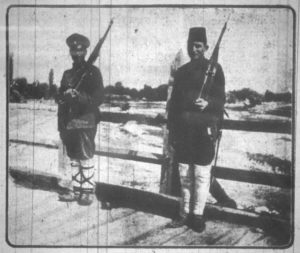My post, The World of Soldiers: Images of British Jewish Soldiers in The Jewish World, during the First World War, presents examples of images of soldiers of the British Commonwealth during the First World War that appeared in The Jewish World, a sister publication of The Jewish Chronicle. Though the overwhelming majority of such photographs in the World were of members of Commonwealth Forces, a small but significant number were of other subjects, notably and naturally Jewish soldiers in the armed forces of other Allied nations. First in number among these pictures are images of French Jewish soldiers, while a second, tiny, but notable few are of Jewish soldiers in the army of Imperial Russia.
Six of these photos are shown below.
Significantly, this small group of images date from the early stages of the war; from autumn of 1914 through 1915, with the “last” picture – of prisoner of war Samuel Mlaver – dating from March of 1916. Like most other pictures in the World, these images are captioned; also like most other pictures in the World, neither the photographer’s name nor the source of the image – whether personal or official – is listed.
Though “at six” this sample is rather tiny (!), it seems that the pictures – except for that of the Russian and Turkish border guards – are formal, studio portraits. (Well, this was decades before Brownie cameras and Kodachrome, and a century before the portable electronic panopticons otherwise “smart”-phones.) Perhaps these portraits were provided to the World by family members of these soldiers, who were then citizens of or recently emigrated to England; England; maybe by correspondents of the Chronicle, World, or other news publications or organizations, then stationed in Saint Petersburg.
Like the portraits in The World of Soldiers, I created these images at the New York Public Library, by taking digital SLR photos of 35mm microfilm copies of the World, as viewed through the display screens of reel-to-reel microfilm readers. The quality of the pictures was then enhanced through Photoshopificationology. (Just kidding: Adobe Photoshop.)
The presence of this very small number of images reflects the much larger attention of The Jewish Chronicle, The Jewish World, The Jewish Exponent (Philadelphia, PA), and l’Univers Israelit, towards the experiences of Russian Jewish soldiers, and Eastern European Jewry – particularly that of Poland and Russia – during the Great War. Appearing in these publications especially from from late 1914 through 1916, such topics as the experiences of Jewish soldiers in the armed forces of Imperial Russia; the fate and suffering of Jewish civilians in Poland amidst the ebb and flow of the German and (especially) Russian armies; the military service of recent Jewish immigrants of Russian origin in England, were the topics of not infrequent focus and discussion. Sometimes briefly; sometimes in very great length and detail.
I hope to bring you the full text of these news items (well, those that I’ve discovered) in future posts.
In any event, in the way that “the map is not the territory”; a musical score is not sound; light is not vision, more than the photos as simple images, what about these five men, as people?
Aside from Jacob Dubov (killed in battle), the subsequent life and fate, as it were – to paraphrase Vasiliy S. Grossman – of Bogdanoff, Mlaver, Persitz, and Williamovsky, is unknown.
Did they survive the Great War?
Did they leave Russia during the chaos between 1917 and the consolidation of Soviet power?
Did they remain in the Soviet Union?
Probably in their forties or fifties by June 22, 1941, did they and their families survive the Second World War?
And afterwards…?
All, unknown.
So, on to the photos…
September 9, 1914
 September 16, 1914: “On the frontier between Turkish and Russian territory. Both soldiers on guard are Jews.”
September 16, 1914: “On the frontier between Turkish and Russian territory. Both soldiers on guard are Jews.”
______________________________
 February 17, 1915: “A portrait of the Russian Jewish Volunteer, Bogdanoff, who had been awarded the Order of St. George for bravery.”
February 17, 1915: “A portrait of the Russian Jewish Volunteer, Bogdanoff, who had been awarded the Order of St. George for bravery.”
______________________________
 April 28, 1915: “S.R. Persitz, who has been awarded a Military Order for bravery.”
April 28, 1915: “S.R. Persitz, who has been awarded a Military Order for bravery.”
______________________________
 May 5, 1915: Russo-Jewish Hero: “Jacob Dubov, who received a Russian order for bravery, was killed on the field of battle.”
May 5, 1915: Russo-Jewish Hero: “Jacob Dubov, who received a Russian order for bravery, was killed on the field of battle.”
______________________________
 June 2, 1915: Head Doctor: “Samuel Williamovsky, who has attained the highest doctor’s rank in the Russian Field Hospitals.”
June 2, 1915: Head Doctor: “Samuel Williamovsky, who has attained the highest doctor’s rank in the Russian Field Hospitals.”
______________________________
 March 8, 1916: “Samuel Mlaver, Russian prisoner of war in Wittenberg.
March 8, 1916: “Samuel Mlaver, Russian prisoner of war in Wittenberg.
